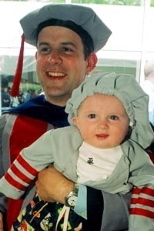MIT graduates receiving doctoral degrees (the Ph.D. or Sc.D.) were invested with their long velvet-lined hoods in Johnson Athletics Center on June 8, with the customary crowded bleacher seating and crush of baby strollers at the door.
President Charles M. Vest welcomed the graduates, their families and friends to the hooding ceremony on behalf of the MIT faculty and Corporation.
"We recognize you today for climbing the highest academic mountain one can imagine, and we know you will make the world a better place," said Vest.
Chancellor Philip M. Clay described the event as "ceremonial work that symbolizes to the world your membership in the academy and your passage from the status of student to that of colleague."
Clay urged the 213 doctoral hood recipients, "Be proud of your achievement! We look forward to long years of association."
MIT's status as a world-class research university and its graduates' seriousness of purpose gave the day its gravitas, but the delight of new doctorates and their rambunctious offspring always add a light touch. It has also become an informal tradition to poke gentle fun at the modern spectacle and medieval roots of robes, the four-foot-long lined hoods, tassels and other accoutria of academe.
In keeping with this, Clay offered a swift fashion reporter's tour of faculty regalia. No longer necessary for warmth or for use as a giant wallet (people once paid robed scholars by tossing coins in their hoods), today's academic regalia is a "modest vestment with no purpose whatsoever. The little pouch in the hood could be used for a small book, a large sandwich or a CD player," Clay suggested.
He singled out for good-natured applause the regalia from the University of Padua, featuring white ermine collar and green satin cowl; Yale University with a slate blue robe, mildly shimmering; Princeton University, in Halloween-candy orange and black; and, of course, "the university up the street," in crimson.
Names of the new doctors of philosophy and doctors of science were read by Samuel Jay Keyser, professor of linguistics emeritus, and presented by faculty members from each school or program.
Looking back at the years spent climbing that "highest academic mountain imaginable," the day's freshly minted doctorates had no regrets about the steep path. Ana Carolina Sartorio of Buenos Aires was encouraged by a friend to seek the academic life in the United States, and she would follow the same path again, "absolutely!" She received the Ph.D. in philosophy.
Sartario and her husband will join the faculty at the University of Wisconsin at Madison as assistant professors. She was pleased and surprised to have learned to play ice hockey while living in New England. "No one plays or watches or is excited about that where I'm from!" she said.
Kaushik Sunderrajan of Madras, India, received the Ph.D. in the Program in Science, Technology and Society. He is headed to a tenure-track position at the University of California at Irvine. "Getting through the [thesis] defense was definitely a high," he said. Would he do it all again? "Yes, for sure," he said.
Looking back and ahead in the same moment, Baylor Fox-Kemper of West Point, Va., hoisted his son, Miles, into his arms. Fox-Kemper, who received the Ph.D. in physical oceanography, adjusted his son's tiny MIT medieval scholar's robe so the folds fell just so and the crimson stripes matched his dad's. "Miles' grandmother, Anne Kemper, made this regalia. We think he likes it!" Fox-Kemper said.






